| |
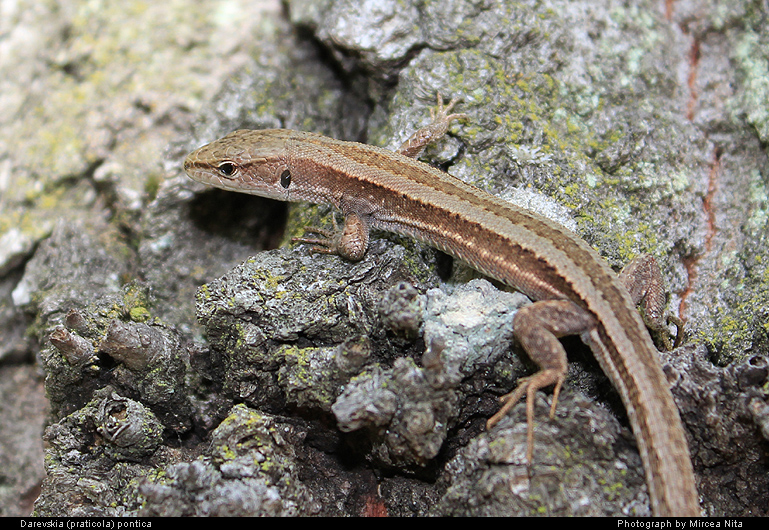

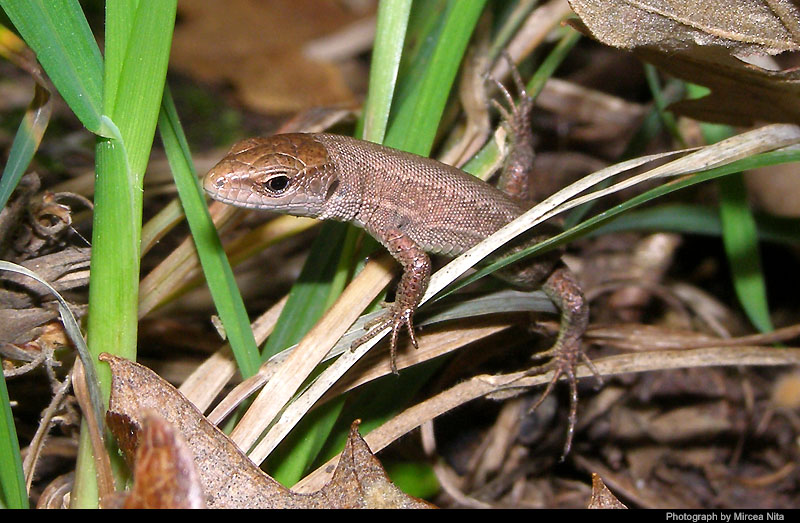
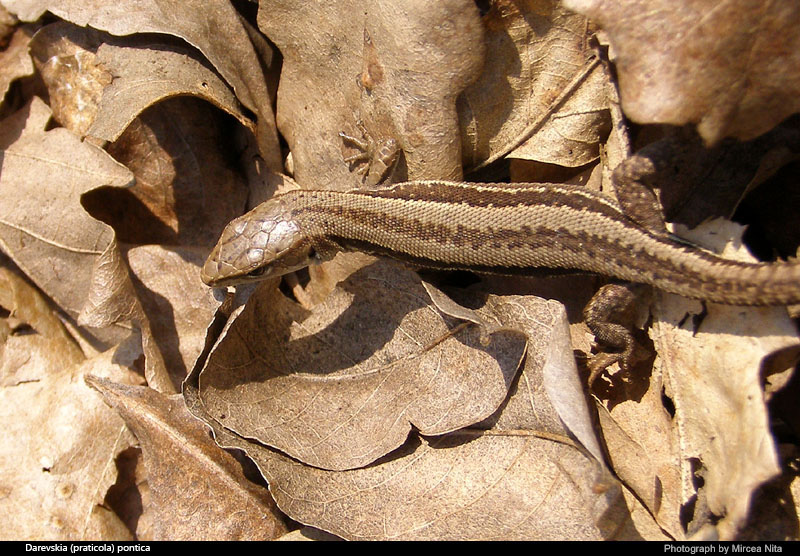
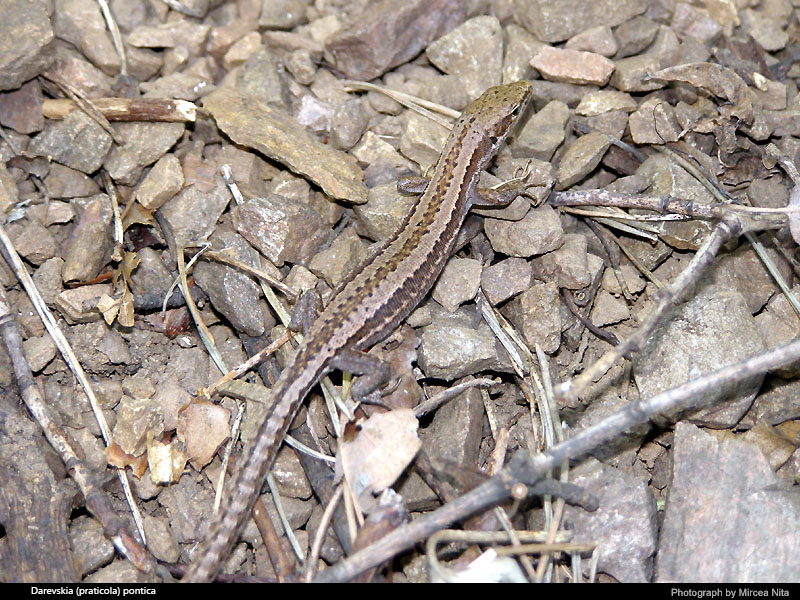
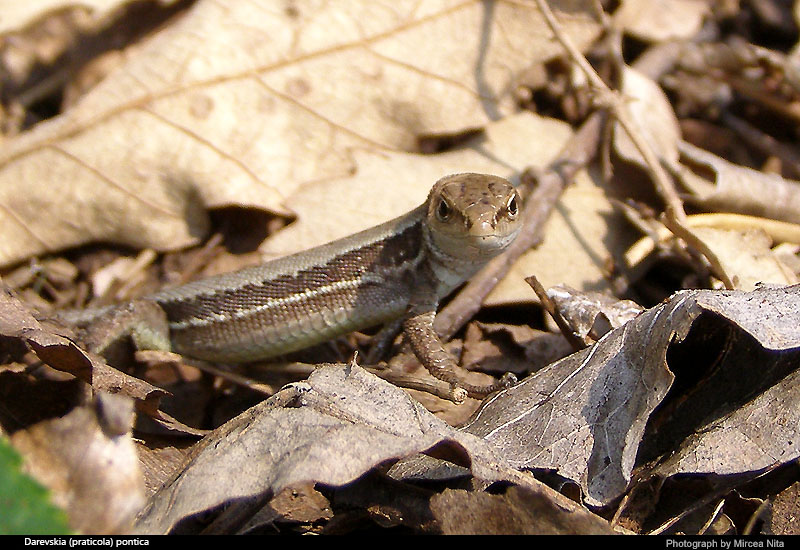
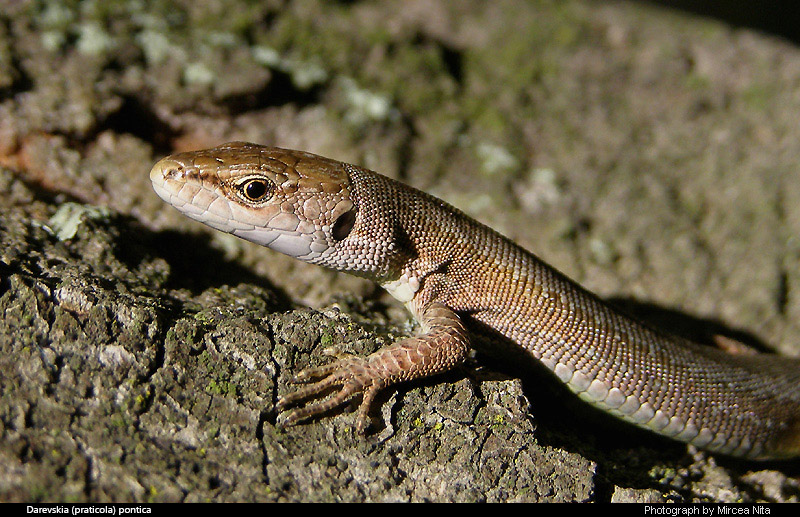
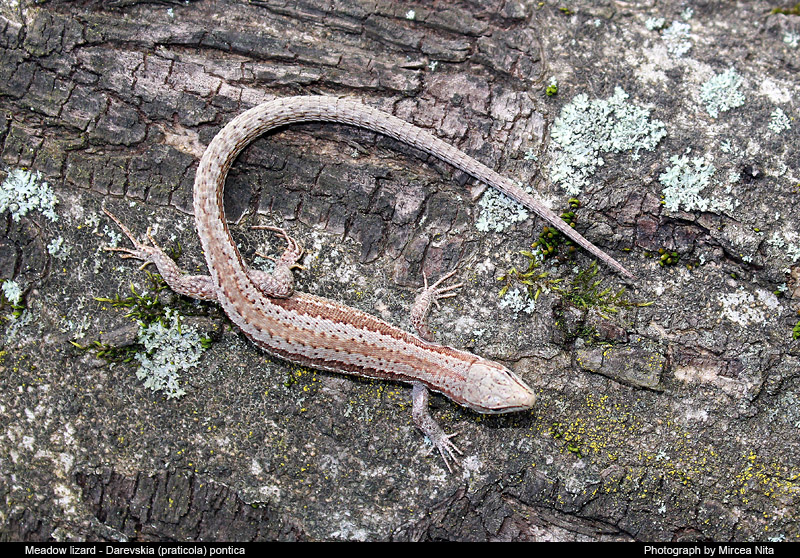
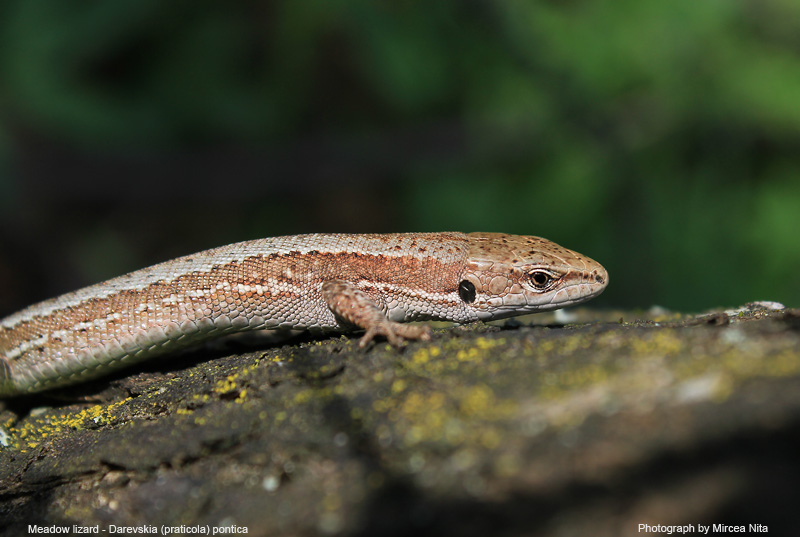
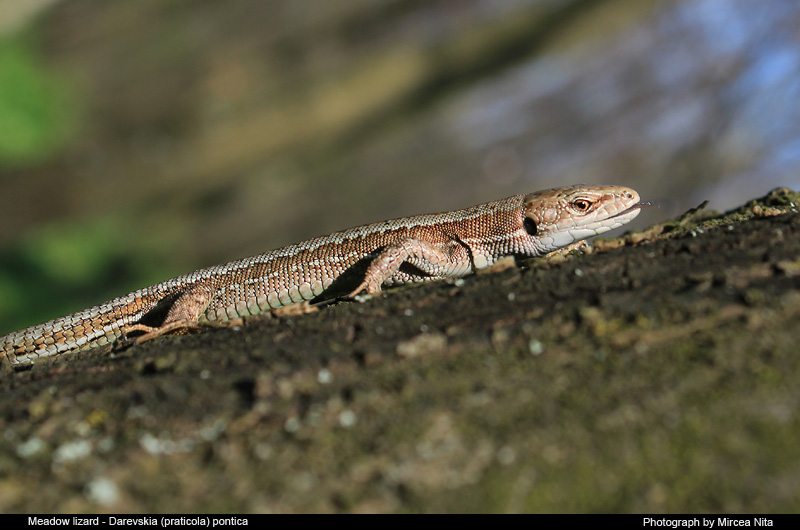


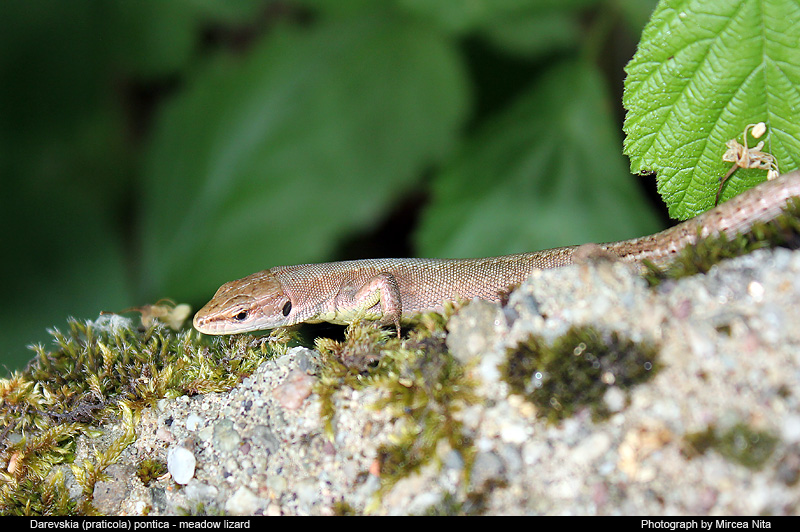
Darevskia pontica
Meadow lizard - Darevskia pontica: Lantz & Cyrén, 1919
Formerly included in the genus Lacerta, this species is now included in the genus Darevskia (Arribas (1998, 1999), Fu et al. (1997), Fu (1998) and Harris et al. (1998)).
Due to the morphological description made by Tuniyev et al., 2011 which is comprehensive and clearly exposed (for further informations see Tuniyev, S. B., Doronin, I. A., Kidov, A. A. & Tuniyev, B. S. 2011. Systematic and geographical variability of meadow lizard, Darevskia praticola (Reptilia: Sauria) in the Caucasus. Russian Jorunal of Herpetology, 18 (4): 295- 316), Darevskia praticola pontica (Lantz & Cyrén, 1919) is now Darevskia pontica (Lantz & Cyrén, 1919).
Description:
This species is distinguished by 6 pairs of chin shields, 3 pairs forming a median suture (Darevskia praticola has 5 pairs of chin shields with 2 pairs forming a median suture).
Total length is between12-14 cm, the tail being almost two thirds from the total length.
Between supraciliaries and supraocularis, dividing them, it has a complete row from about 10 granules (supraciliary granules) on each side; large maseteric region; toothed collar; large femoral pores, which extend to the knees; dorsal scales with well expressed keels; swollened tail base; in front of large anal shield a row from preanal shields.
General color is light-brown or light-reddish, with a darkly-brown or reddish stripe (maximum 7 scale rows width) along vertebral spine and a wide dark-brown or dark-reddish stripe on both lateral sides; between the cervical and lateral stripes, a small number of small reddish spots. Ventrally is yellowish-green on males and yellowish-white on females.
Biology:
This species feeds mainly on insects. Mating occurs during April and May, oviposition period occurs in June, and the young hatch in July. The average clutch size of 5.7 eggs (range 4 - 8) represents the largest recorded for this species. The hibernation starts in October.
Habitat:
Meadow lizard lives in the woods with foliage, including grassy bushes, beeing often found in clearings with lush vegetation, traditional meadows and glades within open broad-leaf woodland and can run easily on tree stems.
Distribution:
Darevskia pontica (Lantz and Cyren, 1919) occurs in very fragmented populations, ranging from eastern and southern Serbia, western and southern Romania, much of Bulgaria (except the southwest), and northeastern Greece (a few records from the margin of its range) to European Turkey (Thrace only). Also inhabits the north-western Caucasus.
Scientific name: Darevskia pontica
Common name: meadow lizard
IUCN Status: Near Threatened
Listed as Near Threatened because this species is probably in significant decline (but probably at a rate of less than 30% over ten years) because of widespread habitat loss through much of its range, most especially in western populations, thus making the species close to qualifying for Vulnerable.
Populations in Central and Southern Europe (including Thrace) are significantly threatened by habitat loss and degradation caused by agricultural intensification (conversion of suitable habitat; overgrazing; agrochemical pollution) (CoE, 2003).
References:
Arnold, E.N. 2003. Reptiles and amphibians of Europe. Princeton University Press., Princeton and Oxford;
Arnold, E.N.; Arribas, O. & Carranza, S. 2007. Systematics of the Palaearctic and Oriental lizard tribe Lacertini (Squamata: Lacertidae: Lacertinae), with descriptions of eight new genera. Zootaxa 1430: 1-86;
Council of Europe. 2003. Convention on the Conservation of European Wildlife and Natural Habitats. Group of experts on the conservation of Amphibians and Reptiles. Mälmo (Sweden), 26-27 September 2003. Report T-PVS (2003) 18;
Covaciu-Marcov, S.D., Cicort-Lucaciu, A.S., Dobre, F., Feren?i, S., Birceanu, M., Mihu?, R. & Str 2009. The herpetofauna of the Jiului Gorge National Park, Romania. North-Western Journal of Zoology 5 (Suppl. 1): 1-78;
Fu, J. 1998. Toward the phylogeny of the family Lacertidae: implications from mitochondrial DNA 12S and 16S gene sequences (Reptilia: Squamata). Molecular Phylogenetics and Evolution 9: 118-130;
Fu, J., Murphy, R.W. and Darevsky, I.S. 1997. Toward the phylogeny of caucasian rock lizards: implications from mitochondrial DNA gene sequences (Reptilia: Lacertidae).Zoological Journal of the Linnean Society: 463-477;
Fuhn, I. & S. Vancea, 1961: Fauna Republicii Române, 14. Reptilia (Testoase, Sopârle, Serpi). Bucuresti;
Gasc, J.-P., Cabela, A., Crnobrnja-Isailovic, J., Dolmen, D., Grossenbacher, K., Haffner, P., Lescure, J., Martens, H., Martínez-Rica, J.P., Maurin, H., Oliveira, M.E., Sofianidou, T.S., Veith, M. and Zuiderwijk, A. 1997. Atlas of Amphibians and Reptiles in Europe. Societas Europaea Herpetologica and Musée National d'Histoire Naturelle, Paris.
Harris, D.J., Arnold, E.N. and Thomas, R.H. 1998. Relationships of lacertid lizards (Reptilia: Lacertidae) estimated from mitochondrial DNA sequences and morphology. Proceedings of the Royal Society London, Series B 265: 1939-1948.
Katarina LJUBISAVLJEVI?, Georg DUKI?, Milo L. KALEZI?: Female reproductive life history traits of the meadow lizard, Darevskia praticola (Eversmann, 1834) (squamata: lacertidae) - from the westernmost boundary of the species range. Polish journal of ecology, 289-297, 2008;
Lantz, L.A. & Cyrén, O. 1919. On Lacerta praticola, Eversm. Ann. Mag. nat. Hist. (9) 3: 28-31;
Lazar, V. et al. 2005. The herpetofauna in the district of Dolj (Romania). Analele Stiintifice ale Universitatii "Al.I. Cuza" Iasi, s. Biologie animala, Tom LI: 151-158
Tuniyev, S. B., Doronin, I. A., Kidov, A. A. & Tuniyev, B. S. 2011. Systematic and geographical variability of meadow lizard, Darevskia praticola (Reptilia: Sauria) in the Caucasus. Russian Jorunal of Herpetology, 18 (4): 295- 316;
IUCN 2012. IUCN Red List of Threatened Species. Version 2011.2;
Sos, T. 2008. Review of recent taxonomic and nomenclatural changes in European Amphibia and Reptilia related to Romanian herpetofauna. Herpetologica Romanica 2.
|
|

